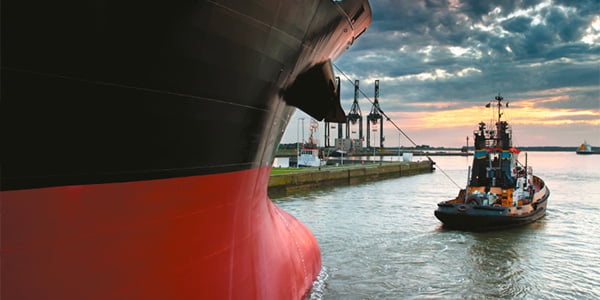Definition & Benefits
A Very Small Aperture Terminal (VSAT) is a two-way satellite ground station with a dish antenna typically ranging from 0.6 m to 1.2 m in diameter. In maritime applications, VSAT enables vessels to maintain continuous broadband Internet, voice, and data services far beyond coastal coverage.
- Global Reach – Access connectivity on global GEO satellite beams, with emerging MEO/LEO options for polar and high latitudes.
- Guaranteed Service – Service Level Agreements (SLAs) ensure committed minimum bandwidth (CIR) and availability, critical for operational and safety applications.
- Scalable Performance – Plans span from a few Mbps for essential communications up to tens of Mbps to support HD video, cloud-based systems, and large data transfers.
- Crew Welfare & Productivity – Reliable email, VoIP, streaming, and remote collaboration tools boost crew morale, retention, and operational efficiency.

Installation & Integration
Site Survey & Design: Placement analysis for optimal sky visibility and electromagnetic compatibility compliance. Selection of appropriate radome size (0.6 m–1.2 m) based on vessel type and required link margin.
System Integration: IP-network integration with firewalls, VPNs, and bandwidth management appliances. Hybrid connectivity setups for automatic failover between VSAT, L-band backup, and 4G/5G mobile connectivity.
Hardware Installation:
Above Deck Unit (ADU): Stabilised, 3-axis antenna with LNB, BUC, and high-power amplifiers, enclosed in a marine-rated radome.
Below Deck Unit (BDU): Modem, Antenna Control Unit (ACU), power supplies, and network routers.Commissioning & Testing: Precision pointing, modem configuration, and end-to-end performance validation. Training for onboard IT staff on network dashboards and maintenance protocols.
Technical Performance
Our VSAT solutions deliver:
Bandwidth & Speed
CIR/MIR plans from 4/2 Mbps up to 50/20 Mbps (and higher on Ka-band).
Burst-able MIR for high-volume transfers.
Latency
GEO: ~600–800 ms round-trip latency.
MEO/LEO options: as low as ~40–100 ms for latency-sensitive applications.
Reliability
≥ 99.9% uptime commitments.
Weather-hardened radomes and link budgets engineered for rain-fade mitigation.
Coverage
Near-global coverage on Ku- and Ka-band GEO satellites, with optional MEO/LEO augmentation for higher latitudes.
Cost Expectations
VSAT involves both CAPEX (terminal hardware + installation) and OPEX (monthly airtime). Rather than listing fixed prices, we encourage you to get a tailored quote to match your vessel’s profile and mission-critical requirements.
Nevertheless, these are the expected range of costs for VSAT connectivity on vessels and yachts.
Hardware & Installation:
VSAT terminal & radome: typically $10,000–$40,000.
Installation & commissioning: $1,000–$5,000 depending on vessel complexity.
Service Plans can range from 500€ for entry-level plans up to +2.000€ per month for global SLAs.
Use Cases
Commercial Shipping – Real-time voyage data reporting, fuel-optimisation routing, crew communications, e-navigation updates.
Passenger Vessels – Guest Wi-Fi, digital ticketing and PAX manifests, telemedicine support, operational logistics.
Offshore Energy – Remote rig monitoring, engineering video consultations, safety alerts, supply-vessel coordination.
Fishing Fleets – Weather downloads, catch reporting, market data feeds, crew welfare communications.
Yachts & Superyachts – High-definition streaming, remote business connectivity, navigation chart updates, guest entertainment.

Regulatory & Compliancce
Our VSAT solutions align with all major maritime regulations and standards:
IMO GMDSS – Supplemental data channel support for safety communications.
Frequency Coordination – Installation complies with ITU and national spectrum regulations to avoid interference.
Data Sovereignty & Encryption – AES-256 VPN tunnels, user-defined firewall policies for GDPR and corporate mandates.
FAQS
What is the difference between Ku-band and C-band in satellite communication?
Ku-band (12–18 GHz) and C-band (4–8 GHz) differ primarily in frequency and antenna size. Ku-band supports smaller antennas and higher throughput but is more sensitive to rain fade; C-band offers superior reliability in heavy precipitation, yet requires larger antenna apertures. Commercial maritime VSAT networks most commonly use Ku-band for compactness and cost-efficient spectrum access.
What are the two types of VSAT?
There are three main VSAT service types, but the two most prevalent maritime variants are:
- DAMA VSAT (Demand Assigned Multiple Access): Dynamically allocates bandwidth among multiple ships to optimise fleet-wide efficiency.
- TDMA VSAT (Time Division Multiple Access): Assigns fixed time slots per vessel, ensuring guaranteed CIR (Committed Information Rate) and predictable performance for mission-critical applications.
How does VSAT actually work on a vessel?
A stabilised antenna tracks a geostationary (or MEO/LEO) satellite, converting uplink and downlink signals via an LNB (Low-Noise Block) and BUC (Block Upconverter). Onboard modems then route IP traffic between the ship’s LAN and the satellite network, with optional L-band or cellular backup for seamless failover.
What are the main disadvantages of VSAT?
The primary drawback is latency—GEO VSAT typically incurs 600–800 ms round-trip delay, which can affect real-time voice/video. VSAT also requires clear sky visibility (radome maintenance) and involves higher upfront CAPEX and monthly airtime fees compared to purely terrestrial solutions.